
The minor shoulder-knot is a moth of the family Noctuidae. The species was first described by Johan Christian Fabricius in 1776. It is distributed throughout Europe then east across the Palearctic to Siberia and Japan. It also occurs in Turkey.

Agrochola lychnidis, the beaded chestnut, is a moth of the family Noctuidae. The species was first described by Michael Denis and Ignaz Schiffermüller in 1775. It is distributed throughout the whole of Europe from Ireland to the Urals. It also occurs in western North Africa and Asia Minor.

Tephriopis is a monotypic moth genus of the family Erebidae. Its only species, Tephriopis divulsa, was first described by Francis Walker in 1865.
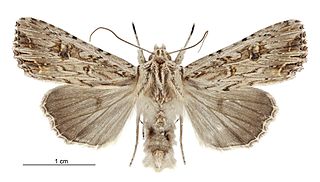
Ichneutica lignana is a moth of the family Noctuidae. It is endemic to New Zealand. This species is found on the Three Kings Islands as well as the North, South and Stewart Islands. This species lives in a variety of habitats including coastal areas, tussock grasslands, shrublands, and native forest, at a range of altitudes from sea level to over 1300 m. I. lignana is quite distinctive in appearance with its dark markings on the abdomen and forewings although it is possible to confuse Ichneutica morosa, Meterana pansicolor and Meterana pascoi with this species. Adults are on the wing throughout the year in the northern parts of the New Zealand but are restricted to the months of October to April in the more southern parts of the country.

Ichneutica insignis is a moth of the family Noctuidae. It is endemic to New Zealand. This species is found throughout New Zealand, although it appears to be scarce in inland sites of tussock grasslands. The adults are on the wing throughout the year. It is a variable species and as such can be easily confused with I. skelloni and I. plena. The larvae of this species have been recorded as feeding on Trifolium pratense.

Aseptis fumosa is a moth of the family Noctuidae first described by Augustus Radcliffe Grote in 1879. It is widespread in western North America and is known from western Canada, Washington, Nebraska, Colorado, Utah, Arizona, Nevada and California. It occurs in a variety of diverse habitats including coast chaparral, dry conifer forest, and shrub steppe.

Paraseptis is a monotypic moth genus in the family Noctuidae erected by Tomas Mustelin and Lars G. Crabo in 2015. Its only species, Paraseptis adnixa, was first described by Augustus Radcliffe Grote in 1880. It is widely distributed along the Pacific Coast from northern Mexico to south-western British Columbia in a variety of forested habitats.
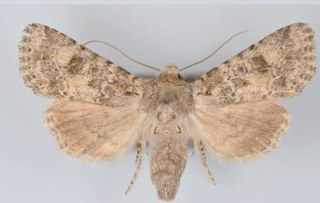
Aseptis catalina is a moth of the family Noctuidae first described by John Bernhardt Smith in 1899. It is found in the deserts of Arizona, California and Baja California in Mexico.

Aseptis ethnica is a moth of the family Noctuidae first described by John Bernhardt Smith in 1899. It is found in North America in Arizona, California, western Oregon, and Baja California Norte in Mexico. The habitat consists of open pine and oak forest and mountain chaparral, mostly at elevations of above 1500 meters in southern California but at lower elevations farther north.

Aseptis characta is a moth of the family Noctuidae first described by Augustus Radcliffe Grote in 1880. It is widespread in western North America, where it is found in the western Great Plains, Great Basin, and Pacific regions from British Columbia, Alberta, and Saskatchewan to Colorado, Utah, northern Arizona and southern California. The species occurs in dry habitats like sagebrush steppe, juniper woodlands, and open forest from sea level to 2,500 meters.

Aseptis fumeola is a moth of the family Noctuidae first described by George Hampson in 1908. It is found in the US state of Arizona, southern and central California, southern Nevada and south-eastern Utah. The habitat consists of foothills and mountains in dry chaparral, parkland, and conifer forest.

Condica dolorosa is a moth of the family Noctuidae. It is found in the Indo-Australian tropics, including Borneo, Hawaii, Hong Kong, India, Sri Lanka, Taiwan and Queensland in Australia.

Ichneutica nullifera is a moth of the family Noctuidae. This species is endemic to New Zealand and can be found in the Tongariro National Park, along the Wellington coast and throughout the South Island. The adults are large and the forewing of adults can vary in colour from pale fawn to dark grey. The larvae are coloured a bright yellow-brown with a paler underside. The larval host species are in the genus Aciphylla and as a result the adult moths are often found in habitat dominated by species in this genus. Adults are on the wing from November to early April and are sometimes attracted to light.

Ichneutica atristriga is a moth of the family Noctuidae. It is endemic to New Zealand and is found through out the North, South and Stewart Islands. The larval hosts likely include tussock grasses included Poa cita, P. colensoi and Festuca novae-zelandiae. Larvae have been reared on species in the genera Bromus and Festuca. The adults of this species are on the wing from November to May. I. atristriga can possibly be confused with the smaller species I. propria. However I. atristriga has thorax and forewings that have a pinkish tinge and I. propria has a dark streak on the discal part of the forewing which I. atristriga lacks. A study has indicated that the population numbers of this species have decreased.

Aseptis ferruginea is a moth of the family Noctuidae first described by Tomas Mustelin in 2000. It is endemic to southern California. All records are from San Diego County, from an area between Boulevard-Manzanita near the Mexican border north to Lake Henshaw at altitudes of 800–1600 meters. The habitat consist of open oak forest, foothill chaparral, and in the mountain-desert transition zone.

Aseptis fanatica is a moth of the family Noctuidae first described by Tomas Mustelin in 2006. It is found in western North America in Washington, Oregon, California, and Baja California Norte in Mexico. It is found in habitats like brush land and open forest in southern California, mostly at 1000–2000 meters, but occurs at lower elevations farther north.
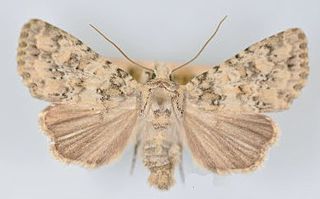
Aseptis pseudolichena is a moth of the family Noctuidae first described by Tomas Mustelin and Ronald Henley Leuschner in 2000. It is endemic to southern California, with records from San Diego, Riverside, Los Angeles, Ventura, San Bernardino, and Tuolumne counties. The habitat consists of open pine and oak forest, open areas with grass and scrub, and foothill chaparral.
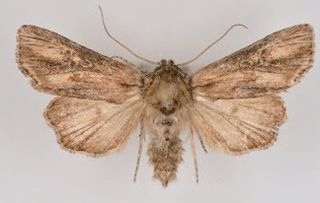
Aseptis susquesa is a moth of the family Noctuidae first described by John Bernhardt Smith in 1908. It is found in Arizona, California and Baja California in Mexico, at least as far south as Ensenada. The habitat consists of rocky areas in the mountain-desert transition zone and high desert.
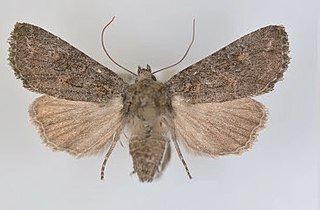
Aseptis perfumosa is a moth of the family Noctuidae first described by George Hampson in 1918. It is endemic to southern California, where it occurs in many habitats such as coastal chaparral and canyons, urban areas, brush land, and open oak forest from sea level to 2000 meters.
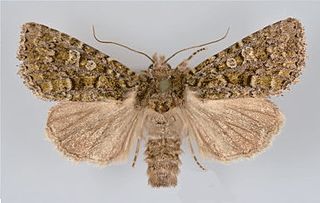
Viridiseptis is a monotypic moth genus in the family Noctuidae erected by Tomas Mustelin and Lars G. Crabo in 2015. Its only species, Viridiseptis marina, was first described by Augustus Radcliffe Grote in 1874. It is found throughout coastal California and in south-western Oregon as far north as Douglas County. It is widely distributed in southern California. It is found in many habitats such as coastal chaparral, mountain forest, mountain-desert transition zone, and occasionally in the deserts from sea level to at least 2000 meters.





















